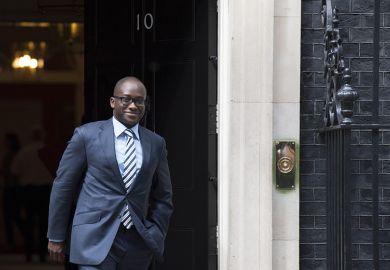Publication of England’s post-18 education review may “slip” so that it can incorporate key work on how student loans are treated in national accounts, work that could increase concerns about the cost of the £9,000 tuition fee regime, according to the review’s leader.
Philip Augar, who heads the panel on the government’s review of post-18 education and funding, also appeared to leave the door open to the panel recommending a cut in headline tuition fees when he spoke at the Universities UK conference.
“The government has said the panel will report at an interim stage and the review itself will be concluded in the early months of 2019,” he told the audience at Sheffield Hallam University. “That is still the timetable we are working to.”
But Mr Augar highlighted the forthcoming Office for National Statistics review of the treatment of student loans in government accounts – expected before the end of the year. The ONS review “makes that [his review’s publication timetable] more complicated, because there is a risk we will be writing across the review. So we are having to look at a number of options.
“But it’s still our intention to produce an interim stage review – hopefully before the end of this year. It’s possible that could slip; it depends entirely on the timing of the ONS review and in fact it’s a decision for the government.”
Mr Augar also said: “The taxpayer’s contribution to higher education is largely concealed from the public eye. It’s largely concealed by the current method of accounting for student loans. And this is the issue at which the Office for National Statistics is looking at the moment.
“We don’t know what the ONS will say. We don’t even know exactly when they are going to say it. But the working assumption has to be that things will change. And presumably will change, at the most extreme end, in terms of bringing more of the debt write-off on to the balance sheet [the deficit measure] and presumably some change in the method of accounting for interest received.
“This will lead, we think, to much more public scrutiny of the taxpayer subsidy for HE. In particular, to the cliff edge in [government] debt that crystallises in the 2040s [when loans from the £9,000 fee regime will first start to be written off].”
The panel was “not yet at the stage where we will make conclusions”, said Mr Augar.
However, he also said on fees: “We support the principle of sharing the burden of the cost of education between the state and the learner. But we need to understand what lies behind the perception around student debt. Are these perceptions true or false? Can they be changed through improved messaging, better information? Or is there a need for more fundamental change?”
On parts of the post-18 education sector that “aren’t working so well”, Mr Augar said that mature, part-time and disadvantaged students, along with further education, were getting a “poor deal”.
He added: “There is also an issue around some low-value degrees. And there is also an issue around the number of young people with degrees who are doing non-graduate jobs.”
Register to continue
Why register?
- Registration is free and only takes a moment
- Once registered, you can read 3 articles a month
- Sign up for our newsletter
Subscribe
Or subscribe for unlimited access to:
- Unlimited access to news, views, insights & reviews
- Digital editions
- Digital access to THE’s university and college rankings analysis
Already registered or a current subscriber?








